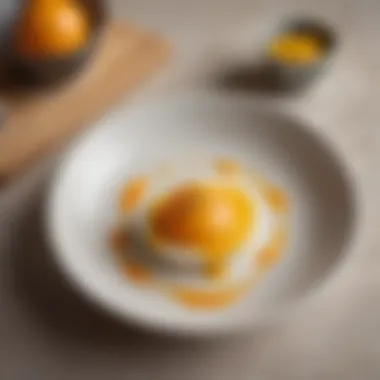The Culinary Importance of Orange Egg Yolks Explained


Intro
In this article, we will explore various aspects of orange egg yolks. We will look at how the yolk's color affects flavor, the cultural perceptions of yolk color, and how hen feed can influence it. By studying these factors, culinary enthusiasts can make informed decisions when selecting eggs and appreciate the art of cooking using this colorful ingredient.
Recipe Overview
- Dish Name: Creamy Orange Yolk Carbonara
- Yield: 4 servings
- Preparation & Cooking Time: 30 minutes
- Difficulty Level: Medium
- Main Ingredients:
- Orange egg yolks
- Spaghetti
- Parmesan cheese
- Black pepper
- Guanciale or pancetta
Step-by-Step Instructions
- Prep Ingredients:
- Cook Pasta:
- Sauté Guanciale:
- Create Sauce:
- Season & Serve:
- Begin by gathering all ingredients.
- Chop guanciale into small pieces.
- Grate Parmesan cheese freshly.
- In a large pot, bring salted water to a boil.
- Add the spaghetti and cook according to package instructions for al dente texture.
- In a pan over medium heat, cook chopped guanciale until crispy. This takes about 5-7 minutes.
- Reserve some fat in the pan. Remove from heat.
- In a bowl, whisk together orange egg yolks and grated Parmesan cheese until creamy.
- Pour the whisked mixture into the pan with guanciale and fat, mixing well with the pasta.
- Add a small amount of pasta water to achieve a desired consistency.
- Add freshly ground black pepper to taste.
- Distribute the carbonara among plates. Optional: Add more cheese on top.
Nutritional Information
- Total Calories per Portion: Approximately 600 calories
- Nutritional Breakdown:
- Key Nutrients: Orange yolks provide vitamins A, D, and E. They also contain beneficial omega-3 fatty acids.
- Proteins: 25g
- Fats: 28g
- Carbohydrates: 60g
Quick Cooking Tips
- Use stovetop or electric pea soup makers for integrating egg yolks into sauces, resulting in silky finishes.
- Multitask by boiling pasta while frying guanciale. This saves time and allows for more efficient cooking.
- For healthier options, consider substiuting whole-wheat spaghetti or pancetta with turkey bacon.
Related Recipes & Variations
- Consider pairing with a simple green salad dressed with olive oil and lemon.
- A tomato-based sauce can be an alternative look for those who avoid creamy dishes.
- Share your creative ideas in cooking techniques using orange egg yolks in the comment section or online communities.
Orange egg yolks not only enhance flavor but also provide vital nutrients necessary for a balanced diet. Choosing vibrant yolks can be a simple yet effective way to elevate home cooking.
Preface to Egg Yolks
The study of egg yolks is crucial for understanding their culinary significance, especially the vibrant orange varieties. Egg yolks, the yellow portion inside an egg, serve several essential functions in cooking and baking, beyond merely being part of a dish. They are reservoirs of flavor, color, and nutrition. It is essential to distinguish between yellow and orange yolks, as their color typically indicates variations in quality and nutrient density.


Overview of Egg Composition
Eggs are comprised of several parts: the shell, egg white, and yolk. The yolk makes up about a third of the egg's total weight. It contains fats, proteins, vitamins, and minerals essential for human health. Orange egg yolks, in particular, are rich in carotenoids, the pigments that give them their color and possess antioxidant properties.
Yolks also contain phospholipids and lecithin, which play a significant role in emulsification, ideal for sauces like mayonnaise or hollandaise. The color of the yolk can range from a pale yellow to a deep orange, suggesting underlying nutrients and influences such as the dietary components provided to the hens.
Importance of Yolks in Culinary Arts
Yolks hold a crucial place in a variety of dishes - from savory sauces to sweet pastries. They are fundamentally responsible for texture, taste, and appearance. The emulsifying ability of yolks allows for the creation of stable mixtures, crucial in diverse culinary techniques. The use of orange yolks signals a quality that can enhance flavors.
Moreover, orange yolks bring visual appeal to dishes. A simple omelet or custard transforms when crafted from vibrant yolks, enhancing not only the aesthetic but the perceived richness and taste. Nutritional advantages apart from uplifting flavors make them indispensable in many gourmet applications.
Characteristics of Orange Egg Yolks
The characteristics of orange egg yolks play a significant role in both culinary art and nutritional science. These vibrant yolks indicate specific aspects about the eggs, from taste and texture to the health benefits they might provide. Understanding these details is crucial not only for chefs and food enthusiasts but for anyone interested in the quality of the foods consumed daily.
Visual Appeal
The visual aspect of orange egg yolks is perhaps the most immediate and striking characteristic. From a culinary standpoint, presentation is a vital ingredient in any dish. When cooked, the shade of yolk affects the overall aesthetic of the food. An orange yolk provides a bold color that can enhance the beauty of plates, making them visually appealing. In many fine dining establishments, chefs often seek these vibrant yolks to add a touch of sophistication. The lustrous, golden hue makes any dish seem more appetizing, indicating richness and flavor.
Another point to consider is consumer perception. Many consumers are drawn to orange egg yolks because they symbolize quality and freshness. A vivid yolk can create an association with healthy, pasture-raised hens, which in turn reflects positively on the product’s marketability. Thus, producers strive for these attributes in their egg-laying hens.
Flavor and Texture Variations
The flavor profiles of orange egg yolks are unique and worthy of exploration. Foods cooked with bright yolks often display a richer and more distinct taste compared to pale yolks. This flavor evolution can often be traced back to the diets of the hens. Hens that consume a diet rich in red or orange pigments, like marigold petals or paprika, tend to produce yolks that are both visually and gastronomically enriched.
Texture is another facet influenced by yolk color. Often, orange egg yolks exhibit a creamier texture, which contributes to the overall mouthfeel of dishes. In custards, sauces, and pastries, this creamy quality facilitates better emulsification and a smooth consistency.
Moreover, the vibrant color and the robust flavor interplay—bringing depth to culinary applications like hollandaise or mayonnaise. When using orange yolks, chefs often observe that their dishes foster a more dynamic flavor journey, leaving a lasting impression on the diner. The change in yolk characteristics also manifests itself in baking, where the buttery, hearty nature can lead to superior muffins and cakes.
“The color of an egg yolk is more than just aesthetic—it serves to indicate diet’s role within the egg's flavor and quality.”
Nutritional Benefits of Orange Yolks
Understanding the nutritional benefits of orange yolks is essential for any culinary enthusiast seeking to elevate their cooking. Orange egg yolks are not only visually appealing but also pack a significant nutritional punch. Sporty orange yolks often indicate a rich diet for the hens, which correlates with higher nutrient content in the egg itself. Therefore, discussing these benefits transcends mere aesthetics in the kitchen and delves into healthful eating.
Comparative Nutritional Analysis
Research indicates that orange egg yolks generally exhibit a richer nutritional profile when compared to their paler counterparts. The difference stems from hen diets weighted heavily in carotenoids, notably beta-carotene, which is found in dark greens, orange, and yellow vegetables. These diets contribute to the vibrant color of the yolk, which typically signifies increased levels of essential nutrients.
Here are some comparative elements that stand out:
- Vitamin A: Orange yolks have higher vitamin A levels than pale ones. This vitamin is vital for maintaining eye health and contributes to proper immune function.
- Omega-3 Fatty Acids: There tends to be a positive relation between yolk color and omega-3 content. Hens that consume diets high in flaxseed or algae produce eggs with elevated omega-3 levels, crucial for brain health.
- Cholesterol: Despite a common belief that high-cholesterol foods should be avoided, studies show that moderate consumption of eggs, particularly those enriched in omega-3's, presents less risk of heart disease compared to other cholesterol sources.
The nutritional contrast suggests that integrating orange yolks into dietary practices can be advantageous due to their richer mineral and vitamin contributions.


Role of Vitamins and Minerals
Egg yolks are nutrient-dense, harboring a variety of vitamins and minerals necessary for optimal health. The darker the color, the more nutrients may be present. Significant vitamins found in orange egg yolks include:
- Vitamin D: Facilitating calcium absorption in the body, vitamin D is vital for bone health. Hens that get sun exposure or consume UV-illuminated feed may produce eggs with higher vitamin D content.
- B Vitamins: Orange yolks are a source of B vitamins, especially B12, necessary for metabolism and neurological function.
- Selenium: Integrity of antioxidants in the body improves with selenium, offering protection from oxidative stress.
- Phosphorus and Iron: Orange yolks contribute phosphorus essential for energy metabolism and bones, while iron is crucial for preventing anemia.
Including orange yolks in culinary practices enriches dishes not only with flavor but with vital nutrients. Careful selection based on yolk color can strongly influence both dietary health outcomes and cooking quality.
Incorporating nutrient-rich orange yolks into recipes is not merely an aesthetic choice, but a strategic one for those mindful of their health.
The commitment to understanding the role of these nutrients in culinary applications offers discerning cooks a valuable perspective on ingredient selection and recipe development.
Factors Influencing Yolk Color
Yolk color is not merely a visual attribute. The hue of an egg yolk is indicative of its nutritional content and ties into culinary practices prominently. Understanding the factors that influence yolk color offers insight into its role in various cooking disciplines. Two key elements play a vital role in determining yolk color: the diet of hens and the specific breeds that lay the eggs. Focusing on these factors, this section will dissect their implications in the kitchen.
Hen Diet and Its Impact
The composition of a hen’s diet greatly influences the richness of an egg’s yolk color. Hens that consume diets high in carotenoids produce more vibrant yolks. Carotenoids are pigment-rich compounds found in several fruits and vegetables, most notably in some leafy greens, carrots, and peppers. When these foods are included in the hen’s feed, the pigments are transmuted into the yolk, enhancing its orange hue.
- Hens that primarily feed on grains and processed feed generally result in paler yolks.
- The freshest and highest-quality eggs typically come from hens that free-range and eat a varied diet.
Researchers suggest that not only the type of feed but also its freshness matters. Fresh ingredients maintain a higher level of carotenoids, which subsequently enrich yolk color. Therefore, opting for eggs from hens with access to a diverse and naturally rich diet often leads to better-quality yolk.
Breeds of Hens That Produce Orange Yolks
Not all hen breeds are equal when it comes to egg yolk pigmentation. Certain breeds tend to produce eggs with more vividly colored yolks. Some of these breeds include:
- Rhode Island Reds
- Leghorns
- Sussex
These breeds usually thrive on a diet that integrates a variety of natural forage, largely contributing to the thickness of their yolks. Generally, knowing the origins of your eggs—from their breeds to diets—can deeply enhance your culinary endeavors. Choosing eggs with orange yolks from dedicated producers reflects commitment toward producing quality food.
It is essential for culinary enthusiasts to recognize that yolk color goes beyond aesthetics; it serves as an indicator of nutritional value and source quality, which are fundamental to better culinary practices.
Culinary Applications of Orange Yolks
Orange egg yolks possess distinct culinary applications that can vastly enrich the cooking experience. Their vibrant color is not only visually appealing, but shell of effects in various recipes, enhancing both flavor and nutritional value. Understanding these applications allows culinary enthusiasts to fully exploit the richness of orange yolks in everyday cooking, making it an important topic within this article.
Enhancing Sauces and Dressings
One of the key uses of orange egg yolks is in the creation of emulsified sauces and dressings, like mayonnaise or hollandaise. The yolk acts as an emulsifier, helping to bind together oil and water in a way that would otherwise not be possible. The reason this is effective with orange yolks may be due to higher fat contents and richer flavors compared to their paler counterparts.
Additionally, using orange yolks can intensify the sensory experience. Their vibrant hue often translates into a bolder taste, therefore, outpacing the taste profiles achieved with lighter yolks. When preparing these sauces, considering that the visual appeal is heightened can stimulate not only the taste buds but also the eyes, making the dish more enjoyable overall.
Rich flavours from orange yolks can also give a deeper, more complex taste to salad dressings, enhancing everything from simple greens to more intricate pasta salads.


Incorporating into Breakfast Dishes
Breakfast is a common scenario where the virtues of orange egg yolks shine through. When made into scrambled eggs or omelets, they provide an appealing color boost that can elevate a basic morning dish into something visually delightful. The rich, creamy texture that orange yolks supply enhances the overall mouthfeel of breakfast offerings.
Another traditional breakfast item where orange yolks shine is in the poached eggs. The egg presents the option for runny yolks, enhancing dishes like eggs Benedict or avocado toast. The vibrant yolk blends into textures and flavors, bringing additional depth and richness.
Culinary enthusiasts can experiment with custards or even pastries where yolks play an essential role. Utilizing these yolks transforms average breakfast dishes into delightful culinary choices, emphasizing the freshness that orange yolks bring straight from the farm.
Baking with Vibrant Yolks
Baking is another realm where orange yolks significantly contribute performance. They not only add richness but affect the texture and color of various baked goods. For example, cake batters enriched with these yolks often yield a denser, more textured final product. The flowers that emerge can demonstrate a warm golden hue, perfectly representing the magnificence of fresh eggs.
Cookies can also take advantage of orange yolks, most notably in recipes calling for churning or rich buttery texture. In such cases, the contribution of flavor becomes an added bonus, alongside the vibrant coloration. Furthermore, desserts like custard-based treats or puddings can greatly benefit, with orange yolks deepening both flavor and aesthetics.
In summary, leveraging orange egg yolks provides crucial advantages across multiple culinary applications. The enhanced colors, textures, and flavors they deliver stress the opportunities available to both home cooks and established chefs. Exploring recipes from sauces to baking opens the pathway toward optimization of this overlooked yet supremely beneficial ingredient.
Common Misconceptions about Yolks
Understanding common misconceptions about egg yolks is essential for culinary enthusiasts. This section clears up uncertainty surrounding yolks, focusing on nutritional myths and quality perceptions linked to yolk color. Misunderstandings can often lead to inefficient cooking choices and less nutritious dishes. Therefore, recognizing reality versus myth can help improve culinary practices.
Nutritional Myths
Nutritional myths about egg yolks abound. Many believe that all yolks are unhealthful due to cholesterol concerns. However, recent research challenges this notion. Yolks are sources of essential nutrients, including omega-3 fatty acids. They also include vitamins A, D, E, and B-complex groups.
- Cholesterol Levels: Studies indicate moderate intake of egg yolks does not raise the risk of heart disease for most people. Individual risk factors play a much larger role here.
- Should Not Be Eaten Daily: Another myth suggests yolks should be consumed infrequently. However, egg yolks have nutritional benefits that support overall health, such as promoting eye health through lutein and zeaxanthin content.
- Full of Empty Calories: Some think these yolks are merely empty calories. In truth, when prepared correctly, an egg yolk provides high-value nutrients that add depth to both flavor and health benefits of meals.
The underlying point here is that embracing egg yolks as part of a balanced diet can yield multiple benefits, especially in healthy cooking.
Quality Perceptions Based on Color
Color influences perceptions of quality in egg yolks. There is a common belief that darker yolks imply superior quality. This opinion is misleading. The yolk color results from the hen's diet rather than indicating egg freshness or overall quality. Diet impacts pigment levels in the yolk, making it more orange or yellow.
- Orange vs. Pale Yolks: A richer orange yolk can suggest a hen has consumed a diet high in carotenoids found in green plants and yellow corn. Despite the vividness of color, this does not necessarily correlate to better taste or health benefits.
- False Indicators: Consequently, one may favor orange yolks, believing they yield more nutritious eggs. Understanding this sheds light on the superficial nature of yolk color related perceptions.
Moreover, freshness test still holds true: checking for bloom or a bitter smell gives a better assessment of quality than color does.
Epilogue
The conclusion of this article underscores the important role of orange egg yolks within culinary practices. An orange yolk offers numerous benefits that contribute significantly to modern cooking. The vibrant color is not merely for aesthetics; it serves as a precursor to the flavors that follow.
Recap of Key Points
To affirm the vital takeaways from our extensive exploration:
- Flavor Profile: Orange egg yolks influence the taste of dishes, often adding richness and depth.
- Nutritional Considerations: The presence of vitamins and minerals in orange yolks surpasses that of paler counterparts. Nutritional value is crucial for meal planning and diet optimization.
- Culinary Flexibility: These yolks enhance various culinary applications, from sauces to baked goods, demonstrating versatility. Chefs can confidently include them in their repertoire.
- Myths Dispelled: Common misconceptions regarding yolk color and nutritional value are clarified. Understanding these aspects is essential for informed culinary decisions.
- Influence of Diet: Hen diet is critical in determining yolk color, hence affecting taste and texture. Knowledge of feed composition empowers producers and consumers alike.
Future Perspectives on Egg Yolk Usage
Looking ahead, it’s evident that the fascination with orange egg yolks is likely to grow. With trends toward natural and organic ingredients, this ambassador of health holds promise.
- Enhanced Culinary Applications: Chefs may begin applying orange egg yolks in innovative ways, further exploring their potential impact on white sauces, custards, or even savory dishes.
- Consumer Awareness: Increased dialogues on egg quality could lead consumers to preferentially choose orange yolks. Market trends may shift as knowledge spreads.
- Research and Development: Future research may enhance our understanding of egg yolk attributes, particularly focusing on breeding and feeding resulting in optimal yolk color and health benefits.
- Food Education: As culinary education evolves, the discussion around yolks will blanket various aspects of cooking, from nutrition classes to professional chef training.







